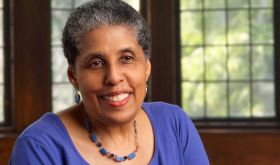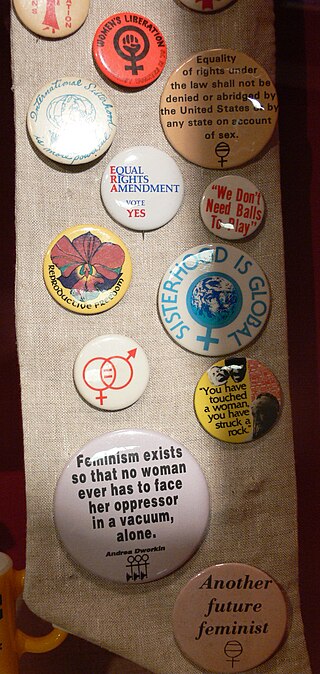Barbare Jorjadze (1833-1895), also known as Barbare Eristavi-Jorjadze, was a Georgian princess, author, and women's rights advocate.
Barbare Jorjadze (1833-1895), also known as Barbare Eristavi-Jorjadze, was a Georgian princess, author, and women's rights advocate.
Jorjadze was born in Kistauri, Georgia in 1833 [1] and the daughter of Prince Davit Eristavi. She was married to Zakaria Jorjadze when she was 12. Her brother was the poet and historian Rapiel Eristavi. [2] [3]

Considered Georgia's first feminist, Jorjadze was a poet, playwright and essayist. [2] She began writing in 1858, publishing poetry in Tsiskari magazine. [4] Despite public criticism, she continued publishing, including in newspapers and magazines such as Droeba , Iveria , Kvali, and Jejili. [1] [4]
In 1861 she was vocal in debates around the modernization of the Georgian language, specifically challenging the ideas of Ilia Chavchavadze. [1]
Jorjadze's play, What I was looking for and what I found, was first staged in 1867 at the Kutaisi Theatre. It was performed for several years and various other theatres. [1]
In 1874 she published the cookbook, Georgian Cuisine and Tried Housekeeping Notes. Published by Ekvtime Kheladze's printing house, it collected recipes for both Georgian and European dishes. [1] Many of her recipes are considered to be standard practice for preparation of traditional Georgian dishes and the book continues to be popular. [2]
Jorjadze penned the letter "A Few of Words to the Attention of Young Men" which was published in 1893 in Kvali magazine. [4] [2] Addressing women's rights, it is considered to be a manifesto of Georgian feminism. [1]
In 2017 the National Parliamentary Library of Georgia named a reading room after Jorjadze. The room also contains murals by Anuk Beluga, depicting Jorjadze and other Georgian female writers and activists. [2] [5]
Feminist science fiction is a subgenre of science fiction focused on such feminist themes as: gender inequality, sexuality, race, economics, reproduction, and environment. Feminist SF is political because of its tendency to critique the dominant culture. Some of the most notable feminist science fiction works have illustrated these themes using utopias to explore a society in which gender differences or gender power imbalances do not exist, or dystopias to explore worlds in which gender inequalities are intensified, thus asserting a need for feminist work to continue.
Science fiction and fantasy serve as important vehicles for feminist thought, particularly as bridges between theory and practice. No other genres so actively invite representations of the ultimate goals of feminism: worlds free of sexism, worlds in which women's contributions are recognized and valued, worlds that explore the diversity of women's desire and sexuality, and worlds that move beyond gender.
Feminist literary criticism is literary criticism informed by feminist theory, or more broadly, by the politics of feminism. It uses the principles and ideology of feminism to critique the language of literature. This school of thought seeks to analyze and describe the ways in which literature portrays the narrative of male domination by exploring the economic, social, political, and psychological forces embedded within literature. This way of thinking and criticizing works can be said to have changed the way literary texts are viewed and studied, as well as changing and expanding the canon of what is commonly taught. It is used a lot in Greek myths.
Anarcha-feminism, also known as anarchist feminism or anarcho-feminism, is a system of analysis which combines the principles and power analysis of anarchist theory with feminism. It closely resembles intersectional feminism. Anarcha-feminism generally posits that patriarchy and traditional gender roles as manifestations of involuntary coercive hierarchy should be replaced by decentralized free association. Anarcha-feminists believe that the struggle against patriarchy is an essential part of class conflict and the anarchist struggle against the state and capitalism. In essence, the philosophy sees anarchist struggle as a necessary component of feminist struggle and vice versa. L. Susan Brown claims that "as anarchism is a political philosophy that opposes all relationships of power, it is inherently feminist".
The history of feminism comprises the narratives of the movements and ideologies which have aimed at equal rights for women. While feminists around the world have differed in causes, goals, and intentions depending on time, culture, and country, most Western feminist historians assert that all movements that work to obtain women's rights should be considered feminist movements, even when they did not apply the term to themselves. Some other historians limit the term "feminist" to the modern feminist movement and its progeny, and use the label "protofeminist" to describe earlier movements.
Postfeminism is an alleged decrease in popular support for feminism from the 1990s onwards. It can be considered a critical way of understanding the changed relations between feminism, femininity and popular culture. The term is sometimes confused with subsequent feminisms such as fourth-wave feminism, postmodern feminism, and xenofeminism.

Cherríe Moraga is an influential Chicana feminist writer, activist, poet, essayist, and playwright. A prominent figure in Chicana literature and feminist theory, Moraga's work explores the intersections of gender, sexuality, race, and class, with particular emphasis on the experiences of Chicana and Indigenous women. She currently serves as Distinguished Professor in the Department of English at the University of California, Santa Barbara.

Islamic feminism is a form of feminism concerned with the role of women in Islam. It aims for the full equality of all Muslims, regardless of gender, in public and private life. Islamic feminists advocate for women's rights, gender equality, and social justice grounded in an Islamic framework. Although rooted in Islam, the movement's pioneers have also utilized secular, Western, or otherwise non-Muslim feminist discourses, and have recognized the role of Islamic feminism as part of an integrated global feminist movement.
Black feminism is a branch of feminism that focuses on the African-American woman's experiences and recognizes the intersectionality of racism and sexism. Black feminism philosophy centers on the idea that "Black women are inherently valuable, that liberation is a necessity not as an adjunct to somebody else's but because of our need as human persons for autonomy."

Barbara Smith is an American lesbian feminist and socialist who has played a significant role in Black feminism in the United States. Since the early 1970s, she has been active as a scholar, activist, critic, lecturer, author, and publisher of Black feminist thought. She has also taught at numerous colleges and universities for 25 years. Smith's essays, reviews, articles, short stories and literary criticism have appeared in a range of publications, including The New York Times Book Review, The Black Scholar, Ms., Gay Community News, The Guardian, The Village Voice, Conditions and The Nation. She has a twin sister, Beverly Smith, who is also a lesbian feminist activist and writer.
Since the 19th century, men have taken part in significant cultural and political responses to feminism within each "wave" of the movement. This includes seeking to establish equal opportunities for women in a range of social relations, generally done through a "strategic leveraging" of male privilege. Feminist men have also argued alongside writers like bell hooks, however, that men's liberation from the socio-cultural constraints of sexism and gender roles is a necessary part of feminist activism and scholarship.

Prince Raphael Eristavi (1824-1901) was a Georgian poet and playwright.

A variety of movements of feminist ideology have developed over the years. They vary in goals, strategies, and affiliations. They often overlap, and some feminists identify themselves with several branches of feminist thought.

The feminist movement, also known as the women's movement, refers to a series of social movements and political campaigns for radical and liberal reforms on women's issues created by inequality between men and women. Such issues are women's liberation, reproductive rights, domestic violence, maternity leave, equal pay, women's suffrage, sexual harassment, and sexual violence. The movement's priorities have expanded since its beginning in the 1800s, and vary among nations and communities. Priorities range from opposition to female genital mutilation in one country, to opposition to the glass ceiling in another.
Native American feminism or Native feminism is, at its root, understanding how gender plays an important role in indigenous communities both historically and in modern-day. As well, Native American feminism deconstructs the racial and broader stereotypes of indigenous peoples, gender, sexuality, while also focusing on decolonization and breaking down the patriarchy and pro-capitalist ideology. As a branch of the broader Indigenous feminism, it similarly prioritizes decolonization, indigenous sovereignty, and the empowerment of indigenous women and girls in the context of Native American and First Nations cultural values and priorities, rather than white, mainstream ones. A central and urgent issue for Native feminists is the Missing and murdered Indigenous women crisis.
Multiracial feminist theory refers to scholarship written by women of color (WOC) that became prominent during the second-wave feminist movement. This body of scholarship "does not offer a singular or unified feminism but a body of knowledge situating women and men in multiple systems of domination."
Feminism in Pakistan refers to the set of movements which aim to define, establish, and defend the rights of women in Pakistan.This may involve the pursuit of equal political, economic, and social rights, alongside equal opportunity. These movements have historically been shaped in response to national and global reconfiguration of power, including colonialism, nationalism, Islamization, dictatorship, democracy, and the War on Terror. The relationship between the women's movement and the Pakistani state has undergone significant shifts from mutual accommodation to confrontation and conflict.

Pragyasundari Devi (1872–1950), also seen as Pragyasundari Debi, Pragya Sundari Devi, Pragasundari Debi, or Prajnasundari Bezbaroa, was an Indian cookbook author and magazine editor. Her Amish O Niramish Ahar was a "significant" early cookbook in the Bengali language.

Anastasia Tumanishvili-Tsereteli (1849–1932) was a Georgian writer and educator who made important contributions to cultural developments in her country, particularly those of women.